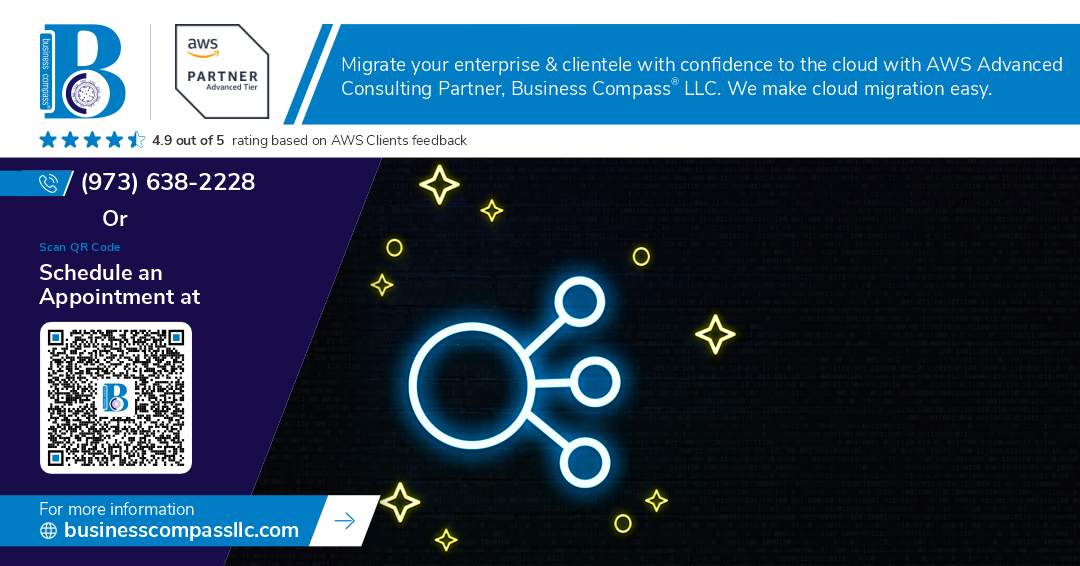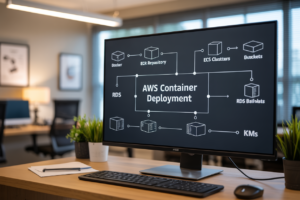Ever been in that sweaty-palms moment when your app crashes during peak traffic? Don’t lie – we’ve all watched those real-time monitors with rising dread as user numbers climb dangerously high.
AWS offers a powerful solution that too many DevOps teams implement incorrectly. The magic happens when Elastic Load Balancers and Auto Scaling Groups work together to maximize uptime and performance.
I’ve seen companies triple their reliability metrics and slash their infrastructure costs by properly configuring these services as partners rather than separate tools. But getting this relationship right requires understanding exactly how ELB and ASG communicate behind the scenes.
Here’s where most tutorials get it wrong – they focus on individual setup steps without explaining the crucial handshakes happening between these services during scaling events.
Understanding AWS ELB and ASG Fundamentals
What is Elastic Load Balancing (ELB) and its key features
ELB is basically AWS’s traffic cop for your applications. It takes incoming traffic and distributes it across multiple targets—could be EC2 instances, containers, or IP addresses—so no single resource gets overwhelmed.
Three main flavors of ELB exist:
- Application Load Balancer (ALB): Handles HTTP/HTTPS traffic with path-based routing
- Network Load Balancer (NLB): Ultra-fast performance for TCP traffic
- Classic Load Balancer: The original version (honestly, use the newer options)
The magic of ELB is that it automatically scales as your traffic grows, performs health checks on your instances, and can even handle SSL termination so your servers don’t have to. It’s also multi-AZ by default, which is ridiculously important for high availability.
Auto Scaling Groups (ASG) explained simply
Think of ASG as your application’s personal fitness trainer. It makes sure you always have the right number of EC2 instances running—not too many (wasting money), not too few (poor performance).
ASG continuously monitors your applications and adjusts capacity based on:
- Scheduled scaling (like for predictable traffic patterns)
- Dynamic scaling (reacting to actual load)
- Predictive scaling (using ML to anticipate needs)
You just set the minimum, maximum, and desired capacity, and ASG handles the rest.
How these services complement each other
ELB and ASG are like peanut butter and jelly—good individually, fantastic together.
When you connect them:
- ASG creates new instances when needed
- These instances automatically register with the ELB
- ELB starts sending traffic only after health checks pass
- When ASG removes instances, ELB stops sending them traffic first
- The whole process is seamless to your users
This partnership creates a self-healing, auto-scaling infrastructure that handles traffic spikes and instance failures without breaking a sweat.
Business benefits of integrating ELB with ASG
The bottom line? This combo delivers serious business advantages:
- Cost optimization: Pay only for what you need, when you need it
- Improved customer experience: No more slow responses during traffic spikes
- Sleep-at-night reliability: Systems recover automatically from failures
- Better developer productivity: Less time fighting fires, more time building features
- Elastic scalability: Handle seasonal demands without pre-provisioning
Companies save thousands (sometimes millions) by right-sizing their infrastructure rather than over-provisioning for worst-case scenarios. And when outages happen (they always do), recovery is automatic and lightning-fast.
ELB Types and Their Specific Benefits
Application Load Balancer for HTTP/HTTPS traffic
Application Load Balancer (ALB) is your go-to solution when you’re dealing with HTTP/HTTPS traffic. It operates at the application layer (Layer 7) and can make routing decisions based on the content of your requests.
What makes ALB special? You can route traffic to different destinations based on URL paths, hostnames, HTTP headers, and query parameters. This is perfect if you’ve got a microservices architecture where different services handle different parts of your application.
/api/* → API servers
/images/* → Image processing servers
/checkout/* → Payment processing servers
ALB also supports WebSockets and HTTP/2, making it ideal for modern web applications. And yes, it handles SSL/TLS termination if you need encrypted connections.
Network Load Balancer for ultra-high performance
When speed is non-negotiable, Network Load Balancer (NLB) has your back. Operating at Layer 4 (transport), it can handle millions of requests per second while maintaining ultra-low latency.
NLB shines for:
- TCP/UDP traffic that needs stable connections
- Gaming servers where every millisecond counts
- IoT applications with massive connection counts
- Static IP addresses that don’t change
It preserves the source IP address of clients, which many security and analytics tools require. If your application demands raw speed and throughput, NLB is your champion.
Classic Load Balancer for legacy applications
The OG of AWS load balancers isn’t the coolest kid on the block anymore, but it still serves a purpose. Classic Load Balancer (CLB) works at both Layer 4 and basic Layer 7, making it a jack-of-all-trades but master of none.
When might you still use CLB?
- You’re running applications on EC2-Classic (the original EC2 platform)
- Your app depends on features specific to CLB
- You’re not ready to refactor your infrastructure for newer load balancers
Consider CLB your compatibility mode while you plan migration to more modern options.
Gateway Load Balancer for third-party virtual appliances
Gateway Load Balancer (GWLB) solves a very specific problem: deploying, scaling, and managing third-party virtual appliances. Think firewalls, intrusion detection systems, and deep packet inspection tools.
GWLB uses the GENEVE protocol to transparently intercept traffic and direct it through your security appliances before it reaches your applications. This creates an inspection layer that scales automatically with your traffic.
What’s clever about GWLB is that it maintains flow stickiness – traffic from a connection always flows through the same appliance instance, which security tools often require to function correctly.
Choosing the right ELB for your workload
Picking the right load balancer isn’t about which one is “best” – it’s about which one fits your specific needs. Here’s a quick decision framework:
- Need content-based routing or running microservices? → ALB
- Need blazing speed or static IPs? → NLB
- Supporting legacy EC2-Classic workloads? → CLB
- Deploying security appliances? → GWLB
Many AWS architecture patterns combine multiple load balancer types. For example, you might use an NLB with static IPs as your internet-facing entry point, then route to an ALB for content-based routing to your microservices.
The right choice depends on your specific AWS uptime optimization goals and performance requirements. Don’t hesitate to mix and match to create the perfect load balancing architecture.
Configuring ASG for Maximum Effectiveness
A. Setting optimal minimum, maximum, and desired capacity
Getting your ASG capacity settings right isn’t just a technical checkbox—it’s the difference between wasting money and watching your application crash during traffic spikes.
Your minimum capacity is your safety net. Don’t set it too low or you’ll risk performance issues during sudden traffic jumps. For critical workloads, I recommend at least two instances spread across availability zones.
Maximum capacity needs careful consideration too. Cloud scalability sounds great until you get that shocking AWS bill. Set realistic limits based on your budget and what your application can actually handle.
Your desired capacity is where your ASG will hover during normal operations. It should comfortably handle your average traffic with some headroom—think 30% buffer for most workloads.
B. Designing effective scaling policies based on metrics
CPU isn’t the only scaling metric that matters. Sure, it’s common, but what about memory usage? Network throughput? Request latency? Custom metrics?
Target tracking policies work wonders for most applications. They maintain a specific metric value—like 70% CPU utilization—by adding or removing instances as needed. Simple and effective.
Step scaling gives you finer control when you need it:
- Minor traffic increase? Add 1 instance
- Major spike? Add 5 instances immediately
CloudWatch alarms trigger these policies, so make sure they’re tuned properly. A premature scale-in could crash your system during a temporary traffic lull.
C. Implementing scheduled scaling for predictable workloads
Monday morning traffic spikes? Black Friday sales? Predictable workloads shouldn’t rely on reactive scaling.
Schedule your capacity increases before you need them:
# Example scheduled scaling actions
8:00 AM weekdays → Scale to 10 instances
6:00 PM weekdays → Scale down to 4 instances
Weekend → Maintain 6 instances
This proactive approach means your users never experience that first-request lag while new instances spin up. They get seamless performance from the moment traffic increases.
And here’s a bonus tip—combine scheduled scaling with dynamic policies as a safety net. The schedule handles your predictable patterns while dynamic scaling catches unexpected traffic.
D. Creating lifecycle hooks for graceful instance handling
Abruptly terminating instances is like hanging up on a customer mid-conversation. Lifecycle hooks let your instances gracefully complete work before shutting down.
During scale-in events, use hooks to:
- Drain connections from your ELB
- Complete in-flight transactions
- Flush logs and metrics
- Deregister from monitoring systems
For scale-out, use hooks to:
- Pre-warm application caches
- Run configuration validation
- Fetch necessary data before accepting traffic
A typical lifecycle hook might give an instance 300 seconds to complete its termination tasks before force-killing it. That’s usually enough time to ensure no data or transactions are lost.
Architecting Highly Available Systems
Multi-AZ Deployment Strategies
Building highly available systems in AWS isn’t rocket science, but it does require strategic thinking. Multi-AZ deployments are your first line of defense against outages. By placing your resources across multiple Availability Zones, you’re essentially telling AWS, “I refuse to let a single data center failure take down my application.”
Here’s how to nail Multi-AZ deployments with ELB and ASG:
- Configure your Auto Scaling Group to span at least two AZs (three is better)
- Set minimum instances per AZ to ensure you’re never caught without coverage
- Use AZ-aware ELB distribution to maintain balance even during partial failures
When done right, your traffic flows seamlessly across healthy instances regardless of where they live.
Health Check Configurations That Accurately Detect Issues
Health checks might seem basic, but they’re often the difference between a hiccup and a full-blown outage. The secret? Don’t just check if a server responds – check if it’s actually doing its job.
Bad health check: "Is the server on?"
Good health check: "Can it process typical user requests correctly?"
Custom health check endpoints that verify database connections, cache availability, and API dependencies will catch problems before your users do. Set thresholds that make sense – typically 2-3 consecutive failures before removing an instance from rotation.
Setting Appropriate Thresholds to Prevent Flapping
Flapping (instances rapidly moving in and out of service) wreaks havoc on system stability. It’s the AWS equivalent of rapidly flipping a light switch on and off.
To prevent this chaos:
- Increase health check grace periods for applications with longer startup times
- Implement gradual cooldown periods between scaling activities
- Use step scaling policies instead of simple scaling
A good rule of thumb: your threshold times should be at least 2-3x your application’s normal response time variance.
Connection Draining to Preserve In-Flight Requests
Nothing frustrates users more than seeing their transaction vanish into thin air because of backend changes. Connection draining (now called “deregistration delay” in ALB/NLB) solves this by giving in-flight requests time to complete.
The magic happens when you set an appropriate draining timeout:
- Too short: Requests get cut off
- Too long: Scaling takes forever
- Just right: Typically 30-120 seconds for most web applications
This small setting dramatically improves user experience during deployments and scaling events.
Cross-Zone Load Balancing to Distribute Traffic Evenly
Cross-zone load balancing is your secret weapon for maximizing resource utilization. Without it, traffic gets distributed to zones, not instances – potentially creating hot spots and wasted capacity.
When enabled, an ELB in us-east-1a will happily send traffic to instances in us-east-1b and us-east-1c, ensuring each instance gets its fair share regardless of how your ASG has distributed them.
This approach not only improves performance but also helps you right-size your infrastructure for optimal cost efficiency while maintaining high availability across your AWS architecture.
Real-World Implementation Strategies
Handling sudden traffic spikes without performance degradation
Traffic spikes happen. Whether it’s Black Friday, a viral social media post, or your app getting featured on Product Hunt – your AWS infrastructure needs to be ready.
Here’s what works best:
Set up predictive scaling in your ASG to anticipate traffic patterns. Unlike reactive scaling (which waits for the spike to happen), predictive scaling uses machine learning to forecast load and scale preemptively.
aws autoscaling put-scaling-policy --auto-scaling-group-name my-asg --policy-name my-predictive-policy --policy-type PredictiveScaling
Combine ELB connection draining with ASG lifecycle hooks to prevent in-flight request failures during scaling events. This keeps user experience smooth even when instances are being added or removed.
For truly massive spikes, implement a multi-tier ASG architecture:
- Tier 1: Always-on instances with reserved pricing
- Tier 2: On-demand instances that scale with normal fluctuations
- Tier 3: Spot instances for cost-effective handling of unexpected peaks
Minimizing costs while maintaining optimal performance
AWS bills keep growing, but they don’t have to. The ELB-ASG combo offers several cost-optimization tricks:
Set your ASG to scale based on SQS queue depth instead of just CPU metrics. This ties your resource usage directly to actual workloads.
Implement scheduled scaling actions for predictable traffic patterns. Why pay for maximum capacity 24/7 when your peak hours are known?
aws autoscaling put-scheduled-update-group-action \
--auto-scaling-group-name my-asg \
--scheduled-action-name scale-up-morning \
--recurrence "0 8 * * *" \
--min-size 5 \
--max-size 10 \
--desired-capacity 5
Use Application Load Balancer (ALB) with content-based routing to direct traffic based on URL paths. This lets you scale different services independently based on their actual usage.
Setting up effective monitoring and alerting
Flying blind with your ELB-ASG setup is asking for trouble. Smart monitoring makes all the difference:
Create CloudWatch dashboards that show correlation between ELB metrics (RequestCount, TargetResponseTime) and ASG metrics (GroupInServiceInstances, CPUUtilization).
Don’t just monitor averages! Set up percentile-based alarms (p90, p99) to catch performance issues affecting a subset of users:
aws cloudwatch put-metric-alarm \
--alarm-name HighP95Latency \
--metric-name TargetResponseTime \
--namespace AWS/ApplicationELB \
--statistic p95 \
--period 60 \
--threshold 1.0 \
--comparison-operator GreaterThanThreshold
Implement canary deployments with CloudWatch Synthetics to catch issues before users do. These synthetic monitors can trace requests through your ELB-ASG setup to spot bottlenecks.
Advanced Optimization Techniques
Session stickiness and its performance implications
Ever noticed how frustrating it is when you’re shopping online and suddenly lose your cart items? That’s why session stickiness matters. In AWS, this feature ensures user requests go to the same EC2 instance that handled their previous requests.
But here’s the catch – stickiness can mess with your load balancer’s ability to distribute traffic evenly. When you pin users to specific instances, some servers might sit idle while others get hammered with requests.
The smart play? Configure session stickiness only when absolutely necessary. For most modern applications, store session data in Amazon ElastiCache or DynamoDB instead. This way, any instance can pick up where another left off, maintaining user experience while keeping your AWS ELB ASG integration working efficiently.
Pre-warming your load balancers for anticipated traffic
Got a big sale coming up? Planning to launch a major feature? Don’t wait for your ELB to scramble when traffic spikes.
Contact AWS Support at least 7 days before your big event. Tell them:
- The expected traffic increase (requests per second)
- The average size of your requests/responses
- Your traffic patterns (gradual increase vs. sudden spike)
This isn’t just a nice-to-have – it’s critical for high availability AWS architecture. Without pre-warming, your load balancer might struggle during those crucial first minutes of traffic surge, causing timeouts or errors.
Implementing proper security groups and network ACLs
Security groups and network ACLs are your traffic cops in AWS land. They work together but serve different purposes:
| Feature | Security Groups | Network ACLs |
|---|---|---|
| Scope | Instance level | Subnet level |
| State | Stateful | Stateless |
| Rules | Allow rules only | Allow and deny rules |
For optimal ELB ASG architecture patterns:
- Configure security groups on your load balancer to accept traffic only from needed sources
- Set up security groups on EC2 instances to accept traffic only from the load balancer
- Use network ACLs as your second defense layer to block suspicious IP ranges
This layered approach tightens security without sacrificing auto scaling performance tuning.
Leveraging CloudWatch metrics for fine-tuning
CloudWatch is your performance detective. The right metrics help spot bottlenecks before users notice them.
Pay special attention to:
- SurgeQueueLength: Shows requests waiting for a backend instance
- SpilloverCount: Requests rejected because the surge queue is full
- RequestCount: Total number of requests
- HealthyHostCount: Available instances for routing
Don’t just collect data – act on it. Set up CloudWatch alarms to trigger Auto Scaling policies. When SurgeQueueLength climbs, automatically add more capacity before users experience slowdowns.
Combine these metrics with custom application metrics for a complete picture of your AWS uptime optimization efforts.
Troubleshooting Common ELB and ASG Integration Issues
A. Diagnosing and resolving scaling problems
Ever notice your AWS environment isn’t scaling when it should? This is super frustrating. Most scaling issues stem from incorrectly configured CloudWatch alarms or inappropriate scaling policies.
Check these first:
- Are your CloudWatch metrics actually triggering?
- Is your scaling policy too conservative?
- Have you hit your maximum capacity limit?
Try this quick fix: Implement step scaling policies instead of simple scaling. They respond more intelligently to demand spikes without the cooldown limitations. For complex workloads, consider predictive scaling based on historical patterns.
# Sample AWS CLI command to check your scaling activities
aws autoscaling describe-scaling-activities --auto-scaling-group-name your-asg-name
B. Handling load balancer capacity constraints
Your ELB showing pre-warming warnings? That’s a capacity issue waiting to happen.
ELBs have limits on how quickly they can scale to handle traffic spikes. When you hit these constraints, your users experience slowdowns or errors.
The smart approach:
- Pre-warm your load balancers before anticipated traffic spikes
- Enable cross-zone load balancing for better distribution
- Monitor the ELB’s surge queue length and spillover metrics
Remember to contact AWS Support before major events. They can pre-provision capacity for your ELBs, saving you from those embarrassing service interruptions.
C. Addressing instance health check failures
Health check failures happen to everyone. When they do, your ASG might terminate perfectly good instances.
Common culprits:
- Overly aggressive health check thresholds
- Instance boot times longer than grace periods
- Application bugs that fail health checks but still function
Fix this by setting appropriate health check grace periods that match your application’s actual startup time. For complex apps, implement custom health checks that accurately reflect your service’s true health.
D. Fixing connection timeout and latency issues
Connection timeouts are where most AWS ELB ASG integration headaches come from. Your application seems fine, but users can’t connect.
First, check these settings:
- Connection draining enabled and properly configured
- Idle timeout settings aligned between ELB and application
- Security groups allowing proper traffic flow
Most timeout issues happen because of mismatched settings between your application servers and the ELB. Match your application’s timeout settings with your load balancer configuration to instantly improve connection reliability.
The combination of AWS Elastic Load Balancing and Auto Scaling Groups creates a powerful foundation for resilient, high-performance applications in the cloud. By distributing traffic efficiently across multiple instances while automatically adjusting capacity based on demand, these services work in tandem to ensure your applications remain available and responsive even during peak loads or instance failures. The various ELB types—Application, Network, Gateway, and Classic—each offer specialized features to address specific use cases, while properly configured ASGs provide the elasticity needed to maintain optimal performance without unnecessary costs.
To maximize the benefits of this integration, focus on implementing proper health checks, setting appropriate scaling policies, and designing your architecture with multiple Availability Zones. When troubleshooting issues, remember to examine both load balancer configurations and scaling triggers. By following the implementation strategies and optimization techniques outlined in this guide, you can create AWS environments that not only survive disruptions but continue delivering exceptional user experiences through any challenge. Take time to review your current setup today—small adjustments to your ELB and ASG configurations could significantly enhance your application’s reliability and performance.




















